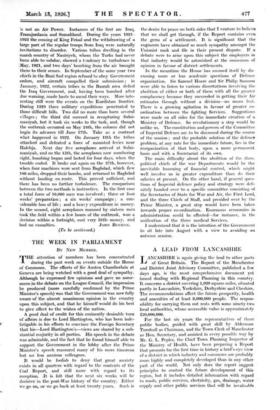A LEAD FROM LANCASHIRE
TANCASIIIRE is again giving the lead to other parts 4 of Great Britain. The Report of the Manchester and District Joint Advisory Committee, published a few days ago, is the most comprehensive document yet issued dealing -with Regional Planning in this country. It concerns a district covering 1,020 square miles, situated partly in Lancashire, Yorkshire, Derbyshire and Cheshire. The recommendations affect the future prosperity, health and amenities of at least 8,000,000 people. The respon- sibility for carrying them out rests with some ninety-two local authorities, whose assessable value is approximately £20,000,000.
For the last six years the representatives of these public bodies, guided with great skill by Alderman Turnbull as Chairman, and the Town Clerk of Manchester as Hon. Secretary, and assisted in every possible way by Mr. G. L. Pepler, the Chief Town Planning Inspector of the Ministry of Health, have been preparing a Report that presents for the first time in history a bird's-eye view of a district in which industry and commerce are probably more highly and completely developed than in any other part of the world. Not only does the report suggest principles to control the future development of this region, but it includes detailed information with regard to roads, public services, electricity, gas, drainage, water supply and other public services that will be invaluable to the decentralized groups which are now beginning to set to work to prepare statutory Town Planning schemes. The good will and enthusiasm with which ninety-two local authorities have co-operated, and the manner in which their efforts have been supported by business men in the north-west of England, certainly sets an example to London. It is true that under the leadership of Mr.
Harold Swann the London County Council is making a survey, but after all the L.C.C. is neither an economic nor a transport unit, and certainly a regional plan for Greater London ought to be prepared on the lines of that outlined in the Manchester Report. But we find Kent, Hertfordshire, Surrey and Middlesex each proceeding with separate joint schemes, which at present are not co- ordinated. Even in the Thames Valley certain local authorities have obstinately refused to join the work of the Joint Committee. Thus parochialism and lack of vision are handicapping the future development of London, and business interests, vitally concerned, ap- parently take no notice. It is to be hoped that those re- sponsible will learn from the example of Manchester.
Only one or two of the main aspects of the Report can be emphasized here. It is, for example, interesting to know that in one of the areas of England that suffers most severely from the results of the Industrial Revolu- tion there is a scheme to create rings of open lands connected by park roads, so as to restrict urban develop- ment, and to redress the balance between towns that will continue to possess their local independence and in- dividuality.
Other aspects of the scheme that deserve special notice are the recommendations to preserve both existing open spaces and historical buildings of the past, such as the timbered Halls in which the district abounds. It is also proposed that the ravines or " cloughs," that at present in many cases are filled with tin cans and other rubbish, should be converted into picturesque open spaces.
The method of procedure indicated is that the Central Committee should continue in existence so as to maintain unity, but that the scheme should be worked out in detail by fourteen decentralized groups. Already nine of these groups have agreed to carry out joint town planning schemes under the 1925 Act. This is a good omen that the work so well begun will be carried in time to a successful































































 Previous page
Previous page